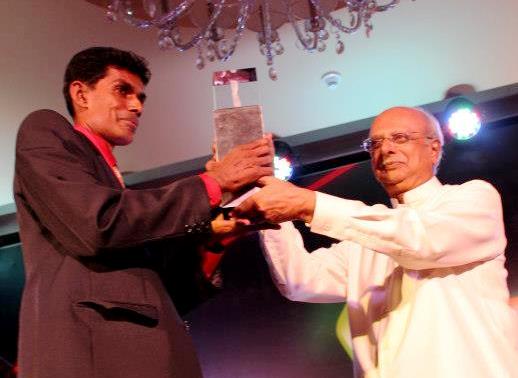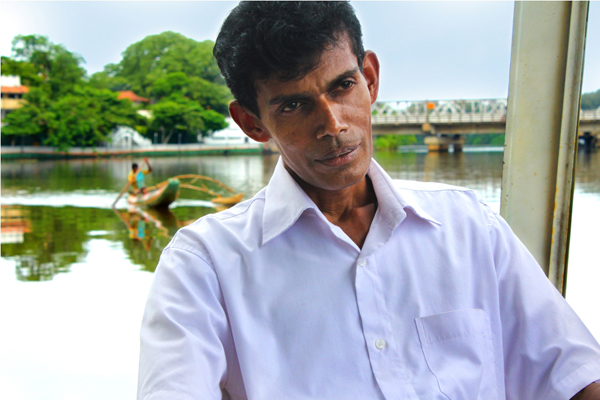Waveless, Eco-friendly Boat wins the ‘Ray Award’ 2012
Colombo, Sri Lanka: 18 October 2012

I S W Karunathilaka, inventor of a wave-less boat design that saves fuel and protects river banks, won the inaugural Ray Award for excellence in innovation and enterprise in Sri Lanka.
An accountant turned entrepreneur, he received the award at a gala awards ceremony held on 17 October 2012 at the Cinnamon Lakeside Hotel, Colombo, amidst an international audience.
The Commercial Bank will provide a grant worth LKR 1 million to assist Karunathilaka to prepare his invention for commercialisation, while the University of Moratuwa will provide technical advice and guidance.
Six Lankan inventors, already honoured with Presidential Awards for Innovation in recent years, were shortlisted for the award. Coming from diverse backgrounds, each had designed a practical solution to an everyday need.
The Ray Award is a biennial, life-time award given in memory of the late Ray Wijewardene, the foremost inventor produced by Sri Lanka, to help a state recognised inventor to commercialise his or her invention. It is administered and presented by the Ray Wijewardene Charitable Trust (RWCT) in collaboration with the Sri Lanka Inventors Commission (SLIC) and the Commercial Bank.
“It was late Dr Ray Wijewardene’s vision and dream to see Sri Lanka develop economically through inventiveness and innovation,” said Dr Tissa Vitarana, Senior Minister of Scientific Affairs, who was chief guest. “The Ray Award celebrates what he stood for.”
“Our inventors need state recognition, society’s appreciation and funding to commercialise their ideas. We really need a good venture capital bank in Sri Lanka to support our inventors – this is what had made a difference in advanced economies like the United States,” he added.
He hoped that RWCT would help Sri Lanka to achieve what the late Ray Wijewardene had in mind: for Sri Lanka to become a developed country without the problems of poverty.
Deepal Sooriyaarachchi, Commissioner of the Sri Lanka Inventors Commission and member of the selection panel said the Ray Award is a celebration of Lankan inventiveness. Long-listed candidates were assessed on three criteria, or three ‘I’s: Invention, Innovation and Impact.
Professor Malik Ranasinghe, Chairman of the Board of Trustees of RWCT, said the Trust supports innovations in sustainable agriculture, renewable energy, engineering and aeronautics – disciplines and pursuits that were close to Ray’s heart.
He added: “We hope that ‘The Ray’ will help to create the next Ray Wijewardene in Sri Lanka.”
All past winners of the Presidential Awards for innovation, presented by SLIC, were eligible and invited to apply for the Ray Award. The Trust received a total of 56 applications, which were reviewed by an independent panel that interviewed 17 candidates.
The selection panel was chaired by Prof Uditha Liyanage, Director and Chairman of the Board of Management, Postgraduate Institute of Management (PIM) affiliated to University of Sri Jayawardenapura.
A documentary featuring the six shortlisted inventors, produced by Ray Wijewardene’s grandson Rehan Alexander Mudannayake, was screened during the awards ceremony.
I S W Karunathilaka: Winner of The Ray Award 2012
The winner of Ray Award 2012, I S W Waidiyarathna Karunathilaka, hails from a family that operated a passenger and cargo ferry on the Kalu Ganga, south of Colombo, during the first half of the twentieth century. When he wanted to revive the family business, he found that motor boats were no longer allowed to operate on Lankan rivers because their waves erode canal and river banks. Undaunted, the innovator experimented with different hull shapes to minimise wave generation. In the end, he came up with a boat that was non-symmetric in shape: rectangular on the outside, but has curves facing the inside. It also contained twin hulls, which allow water to travel through the hollow mid section. This prevents waves being formed on the boat’s sides as it moves. The boat’s propeller is set in the middle of the boat, which further cuts down wave creation and reduces ripples even when the boat travels at high speeds. The boat is eco friendly in other ways too. It consumes less fuel as energy is not wasted in wave generation. Unlike conventional boats made from fibre glass, Karunathilaka’s vessel is made of steel and aluminium, with an anodic protection which reduces corrosion. He has already built an eco-boat that can carry up to 50 passengers or 4,000 kg of cargo, which has been operating on the Kalu Ganga since late 2011. With the Ray Award, he has plans to further improve his design – for example, to see if he can run it on bio energy with a small gasifier on board. He draws inspiration from Ray Wijewardene who popularized biomass gasification among industries in Sri Lanka and pioneered dendro power – burning wood to generate electricity. “An invention is pointless unless it can be commercialised,” says Karunathilaka. “Ray Wijewardene was one of the few people in Sri Lanka who had inventions with commercial value in Sri Lanka. This is why I too want to take my invention to the next levels.” Karunathilaka has been recognized before. He won a Presidential Award for Inventions in 2007, and a silver prize at the Seoul International Invention Fair in 2009. See also profile in The Sunday Times, 23 Sept 2012: http://www.sundaytimes.lk/120923/plus/on-course-on-his-eco-friendly-boat-13240.html |
Shortlist of recognized innovators for The Ray Award 2012
Photo Credits: Mevan Peiries/Snap Photography and Anisha Gooneratne
ODYSSEY Presents: The Ray from ODYSSEY on Vimeo.
More photos of this event can found on our Facebook page (viewing them does not require you to have a Facebook account)







